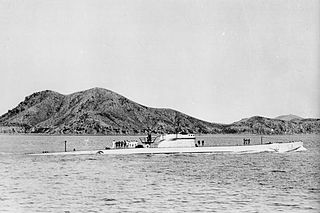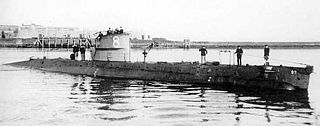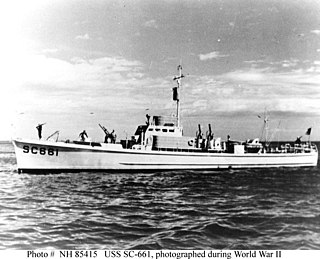The Royal Netherlands Navy is the naval force of the Kingdom of the Netherlands. It is one of the four Netherlands Armed Forces. It was founded on 8 January 1488, making it the third oldest naval force in the world.

Coastal defence ships were warships built for the purpose of coastal defence, mostly during the period from 1860 to 1920. They were small, often cruiser-sized warships that sacrificed speed and range for armour and armament. They were usually attractive to nations that either could not afford full-sized battleships or could be satisfied by specially designed shallow-draft vessels capable of littoral operations close to their own shores. The Nordic countries and Thailand found them particularly appropriate for their island-dotted coastal waters. Some vessels had limited blue-water capabilities; others operated in rivers.
At the outbreak of the Second World War Nazi Germany's Kriegsmarine had 21 destroyers in service, while another one was just being completed. These 22 vessels – comprising 3 classes – had all been built in the 1930s, making them modern vessels. Including that final pre-war vessel, a further 19 were brought into service during the war and more were captured from opposing navies, including the Italian Navy after the Italian Armistice with the Allies in 1943.
The Austro-Hungarian U-boat fleet was created in the decade prior to the First World War. They were built to a variety of designs, many under licence from Germany. They served throughout the war against Italian, French and British shipping in the Mediterranean Sea with some success, losing eight of the twenty eight boats in service in return. They were reinforced by the Imperial German Navy’s Pola Flotilla, mainly comprising coastal U-boats transported by rail from Germany's northern shipyards to the Austrian ports on the Adriatic Sea. Following the end of the war in 1918, all Austrian submarines were surrendered to the Entente powers, who disposed of them individually. As both Austria and Hungary became landlocked in the aftermath of the war, no Austrian or Hungarian submarines have been commissioned since.

German submarine UA was one of fourteen foreign U-boats in the German Kriegsmarine during the Second World War.

Italian submarine Comandante Cappellini was a World War II Italian Marcello-class submarine built for the Italian Royal Navy. After Italy's surrender, the submarine was captured by the Japanese and handed over to Germany as UIT-24. Following the capitulation of Germany, the Japanese integrated the boat into their fleet as I-503. Following the end of the war, the United States scuttled the submarine in 1946.

HMS H6 was a British H-class submarine of the Royal Navy built by Canadian Vickers & Co. during World War I.

HNoMS Ula, previously HMS Varne, a British-built U-class submarine, and a member of the third group of that class to be built. She never actually served under the name Varne, being transferred before commissioning to the exiled Royal Norwegian Navy as HNoMS Ula (S300). In 1944 she sank a German U-boat during one of her patrols off Norway. She remained in Norwegian service and was scrapped in 1965.

The SC-497-class submarine chasers were a class of 438 submarine chasers built primarily for the United States Navy from 1941–1944. The SC-497s were based on the experimental submarine chaser, USS SC-453. Submarine chasers of this variety were collectively nicknamed "the splinter fleet" due to their wooden hulls.
Italian submarine Luigi Torelli was a Marconi-class submarine of the Italian navy during World War II. The vessel operated in the Atlantic from September 1940 until mid-1943, then was sent to the Far East. After Italy's surrender in 1943, the Luigi Torelli was taken over by Nazi Germany's Kriegsmarine, then, in the waning months of the war, the Japanese Imperial Navy. It was one of only two ships to serve in all three major Axis navies, the other being the Italian submarine Comandante Cappellini.
Dundee International Submarine Memorial commemorates the 296 sailors and commandos lost on operations from the submarine base at Dundee in Scotland, HMS Ambrose, during World War II.

HNLMS O 12 was a O 12-class submarine of the Royal Netherlands Navy. Built at Koninklijke Maatschappij De Schelde in Vlissingen, she was launched in 1930 but was unable to take part in military action during World War II. After being scuttled by the Dutch Navy, she was raised by Nazi Germany's Kriegsmarine and taken into service as UD-2, and then scuttled again.

UD-3 was an O 21-class submarine. The boat was laid down as the Dutch submarine HNLMS K XXV and renamed HNLMS O 25 but was captured during the German invasion of the Netherlands in World War II and commissioned in the Kriegsmarine.
UD-4 was an O 21-class submarine. The boat was laid down as the Dutch submarine HNLMS K XXVI and renamed HNLMS O 26 but was captured during German invasion of the Netherlands in World War II and commissioned in the Kriegsmarine.

UD-5 was an O 21-class submarine. The boat was laid down as the Dutch submarine HNLMS K XXVII and renamed HNLMS O 27 but was captured during the German invasion of the Netherlands in World War II and commissioned in the Kriegsmarine. The ship survived the war and was returned to the Netherlands where she served under her old name until 1959.

German submarine U-4706 was a Type XXIII U-boat of Nazi Germany's Kriegsmarine during World War II. She was ordered on 7 July 1944, and was laid down on 14 November 1944 at Friedrich Krupp Germaniawerft AG, Kiel, as yard number 948. She was launched on 19 January 1945 and commissioned under the command of Oberleutnant zur See Manfred Schneider on 7 February 1945.

HNoMS B-5 was a Norwegian B-class submarine which was captured by an E-boat of the Nazi Germany's Kriegsmarine during Operation Weserübung on 9 April 1940 at Kristiansand, Norway. After which she was renamed UC-1 and used as a school boat for the Kriegsmarine before she was deemed unsuited for reserve training and was broken up in 1942.










